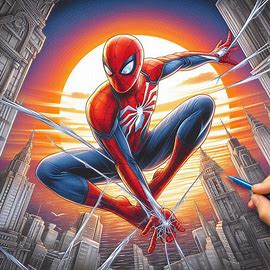Introduction:
Spider-Man is one of the most iconic comic book characters, making him a popular subject for artists across various mediums. In this guide, we’ll explore seven distinct artistic styles that capture Spider-Man’s dynamic nature and offer tips for mastering each one. Whether you’re a beginner or an experienced artist, these styles will help you bring the superhero to life.
1. Traditional Pencil Sketch
For beginners, starting with a pencil sketch allows you to focus on Spider-Man’s essential features, like his sleek silhouette and web details. Start with simple shapes to define his anatomy and use light strokes for shading. Focus on his signature mask and spider emblem for accurate detailing.
Tips:
- Begin with an oval for the head and rough lines for the body.
- Use crosshatching for shading, especially in his muscles and webbing.
- Gradually darken key outlines as you refine details like his suit and pose.
2. Digital Illustration
Digital tools like Adobe Illustrator or Procreate are perfect for creating clean, crisp Spider-Man illustrations. Use layers to separate different elements of your drawing (e.g., background, suit, and webbing), making it easier to adjust and fine-tune.
Tips:
- Start with a base sketch on one layer, then add inking and colors on others.
- Use vibrant reds and blues with high contrast to give Spider-Man’s suit the classic comic book look.
- Add depth using shading and highlights for a more 3D effect.
3. Street Art Murals

Spider-Man’s bold color palette makes him a great subject for large-scale murals. Focus on dynamic poses, like him swinging through the city, to take advantage of the large canvas. Use spray paint for vibrant, eye-catching visuals.
Tips:
- Start with an outline using chalk or light spray paint before filling in the colors.
- Incorporate Spider-Man’s surroundings, like New York City’s skyline, for a more immersive feel.
- Emphasize action lines to capture movement.
4. 3D Sculpting
For a more challenging approach, try creating a 3D model of Spider-Man using clay or digital sculpting software. Focus on getting his anatomy correct, particularly his muscles and signature crouching pose.
Tips:
- Begin by building a wireframe to define Spider-Man’s basic shape.
- Layer clay (or digital material) for details like his suit lines and web shooters.
- Smooth out the final layer and paint his classic red and blue suit for a realistic finish.
5. Watercolor Painting
Watercolors add a soft, expressive quality to Spider-Man’s traditionally bold look. Use lighter washes for his blue areas and more vibrant tones for the red suit, blending them for a unique artistic effect.
Tips:
- Start with a light pencil sketch and gradually build up the colors.
- Use a fine brush for detailed areas like the webbing on his suit.
- Experiment with splatter techniques for background effects to give the painting energy and movement.
6. Comic Book Inking
Inking Spider-Man can help emphasize his sleek, muscular build and iconic costume details. Inking requires precision to capture the dynamic action scenes Spider-Man is known for.
Tips:
- Use a fine-tip ink pen for outlining and a brush pen for thicker areas, like shadows.
- Pay close attention to his webbed suit and mask—these need to be crisp for a classic comic book look.
- Incorporate motion lines to showcase action and movement.
7. Mixed Media Collage
Mixed media art offers a creative approach, combining materials like paper, fabric, and paint to construct a textured image of Spider-Man. Use layers of different materials to highlight his suit, muscles, and dynamic poses.
Tips:
- Use fabric or textured paper for his costume, making the red and blue areas pop.
- Integrate elements like string or wire for webbing effects.
- Layer with paint or markers to emphasize key details like his mask and spider emblem.
Conclusion
No matter which medium or style you choose, drawing Spider-Man allows for plenty of creativity and experimentation. Each of the seven approaches above offers unique ways to capture his dynamic personality, whether you prefer the precision of digital art, the boldness of street murals, or the texture of mixed media. Try experimenting with different styles to find the one that best suits your artistic expression!
Read more at how to draw spider man: 7 Unique Artistic Styles (7barsug8u0w)






